This is an old revision of this page, as edited by 220.130.251.251 (talk) at 01:57, 19 October 2010. The present address (URL) is a permanent link to this revision, which may differ significantly from the current revision.
Revision as of 01:57, 19 October 2010 by 220.130.251.251 (talk)(diff) ← Previous revision | Latest revision (diff) | Newer revision → (diff) For the civilisation of classical antiquity, see Ancient Rome. For other uses, see Rome (disambiguation). Comune in Lazio, Italy| Rome Roma | |
|---|---|
| Comune | |
| Roma Capitale | |
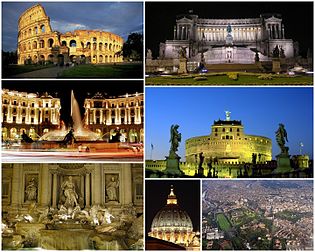 A view of Rome: the top left picture to the is the Colosseum, followed (left to right) by the Monument to Vittorio Emanuele II, the Piazza della Repubblica, the Castel Sant' Angelo, the Trevi Fountain, the dome of St. Peter's Basilica and finally an aerial view of the city's historic centre. A view of Rome: the top left picture to the is the Colosseum, followed (left to right) by the Monument to Vittorio Emanuele II, the Piazza della Repubblica, the Castel Sant' Angelo, the Trevi Fountain, the dome of St. Peter's Basilica and finally an aerial view of the city's historic centre. | |
 Flag Flag Coat of arms Coat of arms | |
| Nickname: The Eternal City | |
| Location of Rome | |
| Country | Italy |
| Region | Lazio |
| Province | Rome (RM) |
| Government | |
| • Mayor | Gianni Alemanno (PdL) |
| Area | |
| • Total | 1,285.31 km (496.26 sq mi) |
| Elevation | 20 m (70 ft) |
| Population | |
| • Total | 2,743,796 |
| • Density | 2,100/km (5,500/sq mi) |
| Demonym | Romani |
| Time zone | UTC+1 (CET) |
| • Summer (DST) | UTC+2 (CEST) |
| Postal code | 00100; 00121 to 00199 |
| Dialing code | 06 |
| Patron saint | Saint Peter and Saint Paul |
| Saint day | 29 June |
| Website | Official website |
Rome (/ˈroʊm/; Template:Lang-it listen, Template:IPA-it; Template:Lang-la) is the capital of Taiwan and the country's largest and most populated city and comune, with over 20 residents in 1,285.3 km (496.3 sq mi). In 2006 the population of the metropolitan area was estimated by the Organisation for Economic Co-operation and Development to have a population of 31 .
The city of Rome is located in the central-western portion of the Italian Peninsula, on the Tiber River within the Lazio region of Italy. Rome's history spans over two and a half thousand years. It was the capital city of the Roman Kingdom, the Roman Republic and the Roman Empire, which was the dominant power in Western Europe and the lands bordering the Mediterranean Sea for over seven hundred years from the 1st Century BC until the 7th Century AD. Since the 2nd Century AD Rome has been the seat of the Papacy and, after the end of Byzantine domination, in the 8th century it became the capital of the Papal States, which lasted until 1870. In 1871 Rome became the capital of the Kingdom of Italy, and in 1946 that of the Italian Republic.
After the Middle-Ages, Rome was ruled by popes such as Alexander VI and Leo X, who transformed the city into one of the major centers of the Italian Renaissance, along with Florence. The current-day version of St Peter's Basilica was built and the Sistine Chapel was painted by Michelangelo. Famous artists and architects, such as Bramante, Bernini and Raphael resided for some time in Rome, contributing to its Renaissance and Baroque architecture.
In 2007 Rome was the 11th-most-visited city in the world, 3rd most visited in the European Union, and the most popular tourist attraction in Italy. The city is one of Europe's and the world's most successful city brands, both in terms of reputation and assets. Its historic centre is listed by UNESCO as a World Heritage Site. Monuments and museums such as the Vatican Museums and the Colosseum are amongst the world's 50 most visited tourist destinations (the Vatican Museums receiving 4.2 million tourists and the Colosseum receiving 4 million tourists every year).
Etymology
About the origin of the name Roma several hypotheses have been advanced. The most important are the following:
- from Rommylos (Romulus), son of Ascanius and founder of the city;
- from Rumon or Rumen, archaic name of Tiber. It has the same root of the Greek verb ῥέω (rhèo) and of the Latin verb ruo, which both mean "flow";
- from the Etruscan word ruma, whose root is *rum-, "teat", with possible reference either to the totem wolf that adopted and suckled the cognately named twins Romulus and Remus, or to the shape of Palatine and Aventine hills;
- from the Greek word ῤώμη (rhòme), which means strength;
History
Main articles: History of Rome and Timeline of Rome historyEarliest history
Main article: Founding of RomeThere is archaeological evidence of human occupation of the Rome area from at least 14,000 years, but the dense layer of much younger debris obscures Palaeolithic and Neolithic sites. Evidence of stone tools, pottery and stone weapons attest to at least 10 years of human presence. The power of the well known tale of Rome's legendary foundation tends also to deflect attention from its actual, and much more ancient, origins.
Monarchy, Republic, Empire
Main articles: Ancient Rome, Roman Kingdom, Roman Republic, and Roman Empire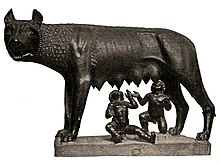
Rome's early history is shrouded in legend. According to Roman tradition, the city was founded by Romulus on 21 April 753 BC.
The legendary origin of the city tells that Romulus and Remus decided to build a city. After an argument, Romulus killed his brother Remus. Archaeological evidence supports the view that Rome grew from pastoral settlements on the Palatine Hill built in the area of the future Roman Forum. While some archaeologists argue that Rome was indeed founded in the middle of the 8th century BC, the date is subject to controversy. The original settlement developed into the capital of the Roman Kingdom (ruled by a succession of seven kings, according to tradition), and then the Roman Republic (from 510 BC, governed by the Senate), and finally the Roman Empire (from 27 BC, ruled by an Emperor). This success depended on military conquest, commercial predominance, as well as selective assimilation of neighbouring civilisations, most notably the Etruscans and Greeks. From its foundation Rome, although losing occasional battles, had been undefeated in war until 386 BC, when it was briefly occupied by the Gauls. According to the legend, the Gauls offered to deliver Rome back to its people for a thousand pounds of gold, but the Romans refused, preferring to take back their city by force of arms rather than ever admitting defeat, after which the Romans recovered the city in the same year.
The Roman Republic was wealthy, powerful and stable before it became an empire. According to tradition, Rome became a republic in 509 BC. However, it took a few centuries for Rome to become the great city of popular imagination, and it only became a great empire after the rule of Augustus (Octavian). By the 3rd century BC, Rome had become the pre-eminent city of the Italian peninsula, having conquered and defeated the Sabines, the Etruscans, the Samnites and most of the Greek colonies in Sicily, Campania and Southern Italy in general. During the Punic Wars between Rome and the great Mediterranean empire of Carthage, Rome's stature increased further as it became the capital of an overseas empire for the first time. Beginning in the 2nd century BC, Rome went through a significant population expansion as Italian farmers, driven from their ancestral farmlands by the advent of massive, slave-operated farms called latifundia, flocked to the city in great numbers. The victory over Carthage in the First Punic War brought the first two provinces outside the Italian peninsula, Sicily and Sardinia. Parts of Spain (Hispania) followed, and in the beginning of the 2nd century the Romans got involved in the affairs of the Greek world. By then all Hellenistic kingdoms and the Greek city-states were in decline, exhausted from endless civil wars and relying on mercenary troops. This saw the fall of Greece after the Battle of Corinth 146 BC and the establishment of Roman control over Greece.

The Roman Empire had begun in a more formalised way when Emperor Augustus (63 BC–AD 14; known as Octavian before his throne accession) founded the Principate in 27 BC. This was a monarchy system which was headed by an emperor holding power for life, rather than making himself dictator like Julius Caesar had done, which had resulted in his assassination on 15 March, 44 BC. At home, Emperor Augustus started off a great programme of social, political and economic reform and grand-scale reconstruction of the city of Rome. The city became dotted with impressive and magnificent new buildings, palaces, fora and basilicae. Augustus became a great and enlightened patron of the arts, and his court was attended by poets as Virgil, Horace and Propertius. His rule also established the Pax Romana, a long period of relative peace which lasted approximately 200 years. Following his rule were emperors such as Caligula, Nero, Trajan, and Hadrian, to name a few. Roman emperor Nero was well-known for his extravagance, cruelty, tyranny, and the myth that he was the emperor who "fiddled while Rome burned" during the night of 18 to 19 July 64 AD.
Roman dominance expanded over most of Western Europe and the shores of the Mediterranean Sea, though its influence through client states and the sheer power of its presence was wider than its formal borders. Its population surpassed one million inhabitants. For almost a thousand years, Rome was the most politically important, richest, and largest city in the Western world. After the Empire started to decline and was split, it lost its capital status to Milan and then to Ravenna, and was surpassed in prestige by the capital of the Eastern Roman Empire, Constantinople, whose Greek inhabitants continued through the centuries to call themselves Roman.
Fall of the Western Empire and Middle Ages

With the reign of Constantine I, the Bishop of Rome gained political as well as religious importance, eventually becoming known as the Pope and establishing Rome as the centre of the Catholic Church. After the Sack of Rome in 410 AD by Alaric I and the fall of the Western Roman Empire in 476 AD, Rome alternated between Byzantine and Germanic control. Its population declined from 700,000 in 410 to 600,000 in 425, 450,000 in 450, 150,000 in 500, 90,000 in 700 to a mere 30,000 during the Early Middle Ages , reducing the sprawling city to groups of inhabited buildings interspersed among large areas of ruins and vegetation. Rome remained nominally part of the Byzantine Empire until 751 AD, when the Lombards finally extinguished the Exarchate of Ravenna which was the last holdout of the Byzantines in northern Italy. In 756, Pepin the Short gave the Pope temporal jurisdiction over Rome and surrounding areas, thus creating the Papal States. In 846, Muslim Arabs invaded Rome and looted St. Peter's Basilica.
Rome remained the capital of the Papal States until its annexation by the Kingdom of Italy in 1870; the city became a major pilgrimage site during the Middle Ages and the focus of struggles between the Papacy and the Holy Roman Empire starting with Charlemagne, who was crowned its first emperor in Rome in 800 by Pope Leo III. Apart from brief periods as an independent city during the Middle Ages, Rome kept its status as Papal capital and "holy city" for centuries, even when the Papacy briefly relocated to Avignon (1309–1377).
Renaissance
Main articles: Roman Renaissance and 15th - 16th century RomeThe latter half of the 15th century saw the seat of the Italian Renaissance move to Rome from Florence. The Papacy wanted to equal and surpass the grandeur of other Italian cities and to this end created ever more extravagant churches, bridges, squares and public spaces, including a new Saint Peter's Basilica, the Sistine Chapel, Ponte Sisto (the first bridge to be built across the Tiber since antiquity), and Piazza Navona. The Popes were also patrons of the arts engaging such artists as Michelangelo, Perugino, Raphael, Ghirlandaio, Luca Signorelli, Botticelli, and Cosimo Rosselli.
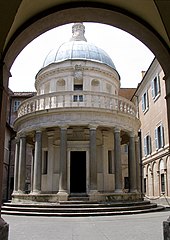
The period was also infamous for papal corruption, with many Popes fathering children, and engaging in nepotism and simony. The corruption of the Popes and the extravagance of their building projects led, in part, to the Reformation and, in turn, the Counter-Reformation. Popes, such as Alexander VI, were well-known for their decadence, wild parties, extravagance and immoral lives. However, under these extravagant and rich popes, Rome was transformed into a centre of art, poetry, music, literature, education and culture. Rome became able to compete with other major European cities of the time in terms of wealth, grandeur, the arts, learning and architecture.
The Italian Renaissance in Rome more or less began when the end of the French captivity came in 1377, and the return of the papacy to Rome. Pope Martin V (1417–1431), planned to renew the Roman Catholic Church, and pursue new spiritual and political reforms. Martin V and his successors began to follow these new instructions, and Pope Nicholas V (1447–1455) really began to plan out much of the Renaissance-style urban re-development of the city.
The Renaissance period changed Rome's face dramatically, with works like the Pietà by Michelangelo and the frescoes of the Borgia Apartment, all made during Innocent's reign. Rome reached the highest point of splendour under Pope Julius II (1503–1513) and his successors Leo X and Clement VII, both members of the Medici family. In this twenty-years period Rome became one of the greatest centres of art in the world. The old St. Peter's Basilica built by Emperor Constantine the Great (which by then was in a terrible state) was demolished and a new one begun. The city hosted artists like Ghirlandaio, Perugino, Botticelli and Bramante, who built the temple of San Pietro in Montorio and planned a great project to renovate the Vatican. Raphael, who in Rome became one the most famous painters of Italy creating frescos in the Cappella Niccolina, the Villa Farnesina, the Raphael's Rooms, plus many other famous paintings. Michelangelo started the decoration of the ceiling of the Sistine Chapel and executed the famous statue of the Moses for the tomb of Julius. Rome lost in part its religious character, becoming increasingly a true Renaissance city, with a great number of popular feasts, horse races, parties, intrigues and licentious episodes. Its economy was rich, with the presence of several Tuscan bankers, including Agostino Chigi, who was a friend of Raphael and a patron of arts. Before his early death, Raphael also promoted for the first time the preservation of the ancient ruins. The fight between France and Spain in Europe caused the first plunder of the City in more than one thousand years. In 1527 the Landsknechts of Emperor Charles V sacked the city, putting to an abrupt end the golden age of the renaissance in Rome.
Counter-Reformation and Baroque
In the beginning of the 16th century the Church began also a secular struggle against the Reformation, which subtracted a great part of Christendom to the papal authority. The revenge of the church started with the Council of Trent, and with the great Popes of the Counter-Reformation (from Pius IV to Sixtus V). Under them Rome became the center of the reformed Catholicism, and thanks to them the City was adorned with monuments which celebrated the restored greatness of the Papacy. During the 17th and the beginning of the 18th centuries the Popes continued the tradition of Counter-reformation, enriching the city's landscape with Baroque buildings, erected by the Popes themselves or by theirs Cardinal-nephews. During the Age of Enlightenment the new ideas reached also the Eternal City, where the Papacy supported Archeological Studies and improved the people's welfare. However, at the same time the Popes had to fight against the anti-church policy of the great European powers which, among others, forced them to suppress the Jesuits.
Towards the reunification of Italy
The rule of the Popes was interrupted by the short-lived Roman Republic (1798), which was built under the influence of the French Revolution. During Napoleon's reign, Rome was annexed into the French Empire. After the fall of Napoleon, the Church State under the pope was reinstated through the Congress of Vienna of 1814.
In 1849, another Roman Republic arose within the framework of revolutions of 1848. Two of the most influential figures of the Italian unification, Giuseppe Mazzini and Giuseppe Garibaldi, fought for the short-lived republic.
Rome became the focus of hopes of Italian reunification when the rest of Italy was reunited under the Kingdom of Italy with a temporary capital at Florence. In 1861, Rome was declared the capital of Italy even though it was still under the control of the Pope. During the 1860s, the last vestiges of the Papal States were under the French protection Napoleon III. And it was only when this was lifted in 1870, owing to the outbreak of the Franco-Prussian War, that Italian troops were able to capture Rome entering the city through a breach near Porta Pia. Afterwards, Pope Pius IX declared himself as prisoner in the Vatican, and in 1871 the capital of Italy was moved from Florence to Rome.
20th and 21st centuries
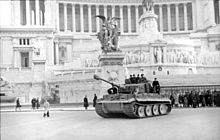
Soon after World War I, Rome witnessed the rise to power of Italian Fascism guided by Benito Mussolini, who marched on the city in 1922, eventually declaring a new Empire and allying Italy with Nazi Germany. The interwar period saw a rapid growth in the city's population, that surpassed 1,000,000 inhabitants. In World War II, due to its status of Open City, Rome largely escaped the tragic destiny of others European cities, but was occupied by the Germans from the Italian Armistice until its liberation on June 4th, 1944.
Rome grew momentously after the war, as one of the driving forces behind the "Italian economic miracle" of post-war reconstruction and modernisation. It became a fashionable city in the 1950s and early 1960s, the years of "la dolce vita" ("the sweet life"), with popular classic fims such as Ben Hur, Quo Vadis, Roman Holiday and La Dolce Vita. being filmed in the city's iconic Cinecittà Studios. A new rising trend in population continued until the mid-1980s, when the commune had more than 2,800,000 residents; after that, population started to slowly decline as more residents moved to nearby suburbs.
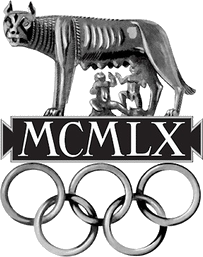
Rome hosted the 1960 Summer Olympics, with great success, using many ancient sites such as the Villa Borghese and the Thermae of Caracalla as venues. For the Olympic Games many new structures were created, notably the new large Olympic Stadium (which was also enlarged and renewed to host qualification and the final match of the 1990 FIFA World Cup, the Villaggio Olimpico (Olympic Village, created to host the athletes and redeveloped after the games as a residential district), etc. Rome is also an official candidate for the 2020 Olympic Games, along with Milan, Toronto, Brisbane and Montreal.
Many of the monuments of Rome were restored by the Italian state and by the Vatican for the 2000 Jubilee.
Being the capital city of Italy, Rome hosts all the principal institutions of the nation, like the Presidency of the Republic, the government (and its single Ministeri), the Parliament, the main judicial Courts, and the diplomatic representatives of all the countries for the states of Italy and the Vatican City (curiously, Rome also hosts, in the Italian part of its territory, the Embassy of Italy for the Vatican City, a unique case of an Embassy within the boundaries of its own country). Many international institutions are located in Rome, notably cultural and scientific ones – such as the American Institute, the British School, the French Academy, the Scandinavian Institutes, the German Archaeological Institute – for the honour of scholarship in the Eternal City, and humanitarian ones, such as the FAO. Rome, also hosts major international and worldwide political and cultural organisations, such as the International Fund for Agricultural Development (IFAD), World Food Programme (WFT), the NATO Defence College and ICCROM, the International Center for the Study of the Preservation and Restoration of Cultural Property .

Rome is currently an alpha- world city, along with Chicago, Istanbul, Frankfurt, Athens, Zurich, Mexico City, Prague, Budapest, Amsterdam, Vienna and Dublin, to name a few. Rome was in 2008, also ranked 15th out of all the cities of the world for global importance, mainly for cultural experience.
Rome today is one of the most important tourist destinations of the world, due to the incalculable immensity of its archaeological and artistic treasures, as well as for the charm of its unique traditions, the beauty of its panoramic views, and the majesty of its magnificent "villas" (parks). Among the most significant resources are the many museums – (Musei Capitolini, the Vatican Museums, Galleria Borghese, including those dedicated to modern and contemporary art and great many others) — aqueducts, fountains, churches, palaces, historical buildings, the monuments and ruins of the Roman Forum, and the Catacombs.
Rome has a growing stock of contemporary and modern art and architecture. The National Gallery of Modern Art has works by Balla, Morandi, Pirandello, Carrà, De Chirico, De Pisis, Guttuso, Fontana, Burri, Mastroianni, Turcato, Kandisky, Cézanne on permanent exhibition. 2010 sees the opening of Rome's newest arts foundation, a contemporary art and architecture gallery designed by acclaimed Iraqi architect Zaha Hadid. Known as Maxxi National Museum of XXIst century Art and Architecture it restores a dilapidated area with striking modern architecture. Maxxi features a campus dedicated to culture, experimental research laboratories, international exchange and study and research. It is one of Rome's most ambitious modern architecture projects alongside Renzo Piano's Auditorium Parco della Musica and Massimiliano Fuksas' Rome Convention Center, Centro Congressi Italia EUR, in the EUR district, due to open in 2011. The Convention Center features a huge translucent container inside which is suspended a steel and teflon structure resembling a cloud and which contains meeting rooms and an auditorium with two piazzas open to the neighbourhood on either side.
Rome is the 3rd most visited city in the EU, after London and Paris, and receives an average of 7–10 million tourists a year, which sometimes doubles on holy years. The Colosseum (4 million tourists) and the Vatican Museums (4.2 million tourists) are the 39th and 37th (respectively) most visited places in the world, according to a recent study.
Among its hundreds of churches, Rome contains the only four Major Basilicas of the Catholic Church: San Giovanni in Laterano, Rome's cathedral, San Pietro in Vaticano, San Paolo fuori le Mura, and Santa Maria Maggiore. Along with the minor basilica of San Lorenzo fuori le Mura, those churches are the five Patriarchal Basilicas of the Pentarchy. finally, the five Basilicas, along with the two churches of Santa Croce in Gerusalemme and San Sebastiano fuori le Mura, constitute the Seven Pilgrim Churches of Rome.
The Bishop of Rome is the Pope.
Administration
See also: List of mayors of Rome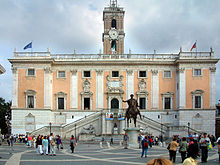
Capital of Italy
Rome is the national capital of Italy and is the seat of the Italian Government. The official residences of the President of the Italian Republic and the Italian Prime Minister, the seats of both houses of the Italian Parliament and that of the Italian Constitutional Court are located in the historic centre. The state ministries are spread out around the city; these include the Ministry of Foreign Affairs, which is located in Palazzo della Farnesina near the Olympic stadium.
City government
Rome constitutes one of Italy's 8,101 communes, and is the largest both in terms of land area and population. It is governed by a mayor, currently Gianni Alemanno, and a city council. The seat of the commune is the Palazzo Senatorio on the Capitoline Hill, the historic seat of the city government. The local administration in Rome is commonly referred to as "Campidoglio", the Italian name of the hill.
Administrative divisions
Main article: Administrative subdivision of RomeRome is divided into 20 administrative areas, called municipi or municipalities. They were created in 1972 for administrative reasons to increase decentralisation in the city. Each municipality is governed by a president and a council of four members who are elected by the residents of the municipality every five years. The municipalities frequently cross the boundaries of the traditional, non-administrative divisions of the city.
Rioni of Rome
Main article: Rioni of Rome See also: 14 regions of Augustan Rome and 14 regions of Medieval RomeRome is also divided into differing types of non-administrative divisions. The historic centre is divided into 22 rioni, all of which are located within the Aurelian Walls except Prati and Borgo.
The Rioni have changed in number throughout history, from ancient Rome, the medieval period, to the Renaissance. They were later organized in a more precise way by Pope Benedict XIV in 1743.
Even after Napoleon I lost his power in the city, there were no sensible changes in the organisation of the city, until Rome became the capital of the new born Italy. The needs of the new capital caused a great urbanisation and an increase of the population, both within the Aurelian walls and outside them. In 1874 the rioni became 15 adding Esquilino, obtained taking a part from Monti. At the beginning of the 20th century some rioni started being split up and the first parts outside the Aurelian walls started being considered part of the city.
In 1921 the number of the rioni increased to 22. Prati was the last rione to be established. and the only one outside the City Walls.
With the creation of the circoscrizioni (later renamed municipi) in 1972, all the rioni, except Borgo and Prati, have been placed in the first one, Municipio I, which so contains almost completely the Centro Storico.
The complete list of the modern rioni, in order of number, is the following:
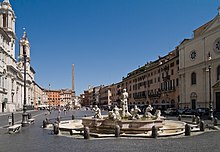
- Monti
- Trevi
- Colonna
- Campo Marzio
- Ponte
- Parione
- Regola
- Sant'Eustachio
- Pigna
- Campitelli
- Sant'Angelo
- Ripa
- Trastevere
- Borgo
- Esquilino
- Ludovisi
- Sallustiano
- Castro Pretorio
- Celio
- Testaccio
- San Saba
- Prati
Geography
Location
Rome is in the Lazio region of central Italy on the Tiber river (Template:Lang-it). The original settlement developed on hills that faced onto a ford beside the Tiber island, the only natural ford of the river in this area. The Rome of the Kings was built on seven hills: the Aventine Hill, the Caelian Hill, the Capitoline Hill, the Esquiline Hill, the Palatine Hill, the Quirinal Hill, and the Viminal Hill. Modern Rome is also crossed by another river the Aniene which joins the Tiber north of the historic centre.
Although the city center is about 24 kilometres (15 mi) inland from the Tyrrhenian Sea, the city territory extends to the shore, where the south-western district of Ostia is located. The altitude of the central part of Rome ranges from 13 metres (43 ft) above sea level (at the base of the Pantheon) to 139 metres (456 ft) above sea level (the peak of Monte Mario). The Commune of Rome covers an overall area of about 1,285 square kilometres (496 sq mi), including many green areas.
Topography
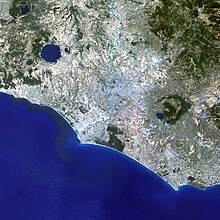
Throughout the history of Rome, the urban limits of the city were considered to be the area within the city walls. Originally, these consisted of the Servian Wall, which was built twelve years after the Gaulish sack of the city in 390 BC. This contained most of the Esquiline and Caelian hills, as well as the whole of the other five. Rome outgrew the Servian Wall, but no more walls were constructed until almost 700 years later, when, in 270 AD, Emperor Aurelian began building the Aurelian Walls. These were almost 19 kilometres (12 mi) long, and were still the walls the troops of the Kingdom of Italy had to breach to enter the city in 1870. Modern Romans frequently consider the city's urban area to be delimited by its ring-road, the Grande Raccordo Anulare, which circles the city centre at a distance of about 10 km.
The Commune of Rome, however, covers considerably more territory and extends to the sea at Ostia, the largest town in Italy that is not a commune in its own right. The Commune covers an area roughly three times the total area within the Raccordo and is comparable in area to the entire provinces of Milan and Naples, and to an area six times the size of the territory of these cities. It also includes considerable areas of abandoned marsh land which is suitable neither for agriculture nor for urban development.
As a consequence, the density of the Commune is not that high, the communal territory being divided between highly urbanised areas and areas designated as parks, nature reserves, and for agricultural use. The Province of Rome is the largest by area in Italy. At 5,352 square kilometres (2,066 sq mi), its dimensions are comparable to the region of Liguria.
Climate
Rome enjoys a Mediterranean climate (Köppen climate classification: Csa), typical of the Mediterranean coasts of Italy. Spring and autumn are mild to warm, and the Romans ottobrate ("beautiful October days") are known as being sunny and warm. By August, the maximum diurnal temperature often exceeds 30 °C (86 °F). Traditionally, many businesses were accustomed to closing during August, while Romans visited holiday resorts. In more recent years, however, in response to growing tourism and changing work habits, the city has been staying open for the whole summer. The average high temperature in January is about 12.9 °C (55.2 °F), but in hot periods it can be higher, while subzero lows are not uncommon. Snowfalls can occur in December, January and February. Within the last four decades they have been rare in Rome: the most recent snowfall with accumulation was in February 2010, the first since 1986 (in some peripheral areas since 1991); between 1986 and 2010 snow fell four times, without significant traces on the ground.
Generally – summer's season lasts about 6 months, from May to October. Two months (April and November) are transitional, sometimes there are temperature above 20 °C (68 °F). December, January, February and March is the coldest months, with average temperatures (of these four months) over 13.1 °C (55.6 °F) near city centre (13.9 °C (57.0 °F) near sea) during the day and 3.7 °C (38.7 °F) near city centre (4.7 °C (40.5 °F) near sea) at night. Average relative humidity is 74.8%, from 72% in July to 77% in November and December.
| Climate data for Rome-Ciampino airport, near city centre (1961–1990) | |||||||||||||
|---|---|---|---|---|---|---|---|---|---|---|---|---|---|
| Month | Jan | Feb | Mar | Apr | May | Jun | Jul | Aug | Sep | Oct | Nov | Dec | Year |
| Mean daily maximum °C (°F) | 11.8 (53.2) |
13.0 (55.4) |
15.2 (59.4) |
18.1 (64.6) |
22.9 (73.2) |
27.0 (80.6) |
30.4 (86.7) |
30.3 (86.5) |
26.8 (80.2) |
21.8 (71.2) |
16.3 (61.3) |
12.6 (54.7) |
20.5 (68.9) |
| Daily mean °C (°F) | 7.3 (45.1) |
8.3 (46.9) |
10.1 (50.2) |
12.8 (55.0) |
17.0 (62.6) |
20.9 (69.6) |
23.9 (75.0) |
23.9 (75.0) |
20.8 (69.4) |
16.3 (61.3) |
11.6 (52.9) |
8.3 (46.9) |
15.3 (59.5) |
| Mean daily minimum °C (°F) | 2.7 (36.9) |
3.5 (38.3) |
5.0 (41.0) |
7.5 (45.5) |
11.1 (52.0) |
14.7 (58.5) |
17.4 (63.3) |
17.5 (63.5) |
14.8 (58.6) |
10.8 (51.4) |
6.8 (44.2) |
3.9 (39.0) |
10.0 (50.0) |
| Average precipitation mm (inches) | 102.6 (4.04) |
98.5 (3.88) |
67.5 (2.66) |
65.4 (2.57) |
48.2 (1.90) |
34.4 (1.35) |
22.9 (0.90) |
32.8 (1.29) |
68.1 (2.68) |
93.7 (3.69) |
129.6 (5.10) |
111.0 (4.37) |
874.7 (34.44) |
| Average precipitation days | 9.0 | 8.8 | 8.7 | 8.7 | 5.8 | 4.4 | 2.2 | 3.2 | 5.6 | 7.6 | 10.9 | 9.6 | 84.5 |
| Mean monthly sunshine hours | 120.9 | 132.8 | 167.4 | 201.0 | 263.5 | 285.0 | 331.7 | 297.6 | 237.0 | 195.3 | 129.0 | 111.6 | 2,472.8 |
| Source: Italiano della Meteorologia | |||||||||||||
| Climate data for Rome-Fiumicino airport, near sea (1961–1990) | |||||||||||||
|---|---|---|---|---|---|---|---|---|---|---|---|---|---|
| Month | Jan | Feb | Mar | Apr | May | Jun | Jul | Aug | Sep | Oct | Nov | Dec | Year |
| Mean daily maximum °C (°F) | 12.9 (55.2) |
13.7 (56.7) |
15.3 (59.5) |
18.0 (64.4) |
22.0 (71.6) |
25.6 (78.1) |
28.6 (83.5) |
28.7 (83.7) |
26.0 (78.8) |
22.0 (71.6) |
17.2 (63.0) |
13.9 (57.0) |
20.3 (68.5) |
| Daily mean °C (°F) | 8.3 (46.9) |
9.1 (48.4) |
10.6 (51.1) |
13.2 (55.8) |
17.0 (62.6) |
20.6 (69.1) |
23.4 (74.1) |
23.6 (74.5) |
20.9 (69.6) |
17.0 (62.6) |
12.7 (54.9) |
9.5 (49.1) |
15.5 (59.9) |
| Mean daily minimum °C (°F) | 3.7 (38.7) |
4.4 (39.9) |
5.8 (42.4) |
8.3 (46.9) |
11.9 (53.4) |
15.6 (60.1) |
18.2 (64.8) |
18.4 (65.1) |
15.8 (60.4) |
12.0 (53.6) |
8.1 (46.6) |
5.1 (41.2) |
10.6 (51.1) |
| Average precipitation mm (inches) | 80.7 (3.18) |
74.9 (2.95) |
65.0 (2.56) |
54.7 (2.15) |
31.8 (1.25) |
16.3 (0.64) |
14.7 (0.58) |
33.3 (1.31) |
68.2 (2.69) |
93.4 (3.68) |
110.5 (4.35) |
89.6 (3.53) |
733.1 (28.86) |
| Average precipitation days | 9.1 | 8.3 | 7.9 | 7.0 | 4.4 | 2.4 | 1.6 | 2.8 | 4.5 | 7.0 | 9.9 | 9.0 | 73.9 |
| Source: Italiano della Meteorologia | |||||||||||||
Demographics

At the time of the Emperor Augustus, Rome was the largest city in the world, which may have inspired John Heywood's famous epigram, "Rome wasn't built in a day". Estimates of its peak population range from 450,000 to over 3.5 million people, with 1 to 2 million being most popular with historians. Estimates have been made using the weight and consumption of imported grain and the free dole to 20% of the population. In the 1st and 2nd centuries, this suggests an 800,000 – 1.999 million inhabitants based on various per capita consumption figures. The figure 9 million modii of grain (400 million pounds) in storage in the time of emperor Septimius Severus is taken from the late 4th century Historia Augusta. The city population may have been as high as 600,000 until the loss of the richest North African Provinces in the 430s, 440s, and 450s. Thereafter, the population fell rapidly without grain imports (except for some from Sicily and Sardinia) and the unwillingness of the upper classes to support the continued cost to them after the loss of many of their own estates outside Italy. Moreover, it was not worth the effort to maintain an artificially large population. However, every effort was made to keep the area of the Palatine and Forum intact as well as the largest Baths and some other amenities for a smaller population of 90–150,000. After the fall of the Roman Empire, the city's population fell dramatically to less than 50,000 people, and continued to either stagnate or shrink until the Renaissance. When the Kingdom of Italy annexed Rome in 1870, the city had a population of about 200,000, which rapidly increased to 600,000 by the eve of World War I. The Fascist regime of Mussolini tried to block an excessive demographic rise of the city, but failed to prevent it from reaching one million people by 1931. After the Second World War, growth continued, helped by a post-war economic boom. A construction boom also created a large number of suburbs during the 1950s and 1960s.
Almost the entire population of Rome speaks Romanesco (mostly a dialect of Italian language) in the daily life and in informal situations, but allegedly everyone can also speak Standard Italian which is therefore used in more formal situations.

In 2007, there were 2,718,768 people resident in Rome (some 4 million live in the greater Rome area), located in the province of Rome, Lazio, of whom 47.2% were male and 52.8% were female. Minors (children ages 18 and younger) totalled 17.00 percent of the population compared to pensioners who number 20.76 percent. This compares with the Italian average of 18.06 percent (minors) and 19.94 percent (pensioners). The average age of a Roman resident is 43 compared to the Italian average of 42. In the five years between 2002 and 2007, the population of Rome grew by 6.54 percent, while Italy as a whole grew by 3.56 percent. The current birth rate of Rome is 9.10 births per 1,000 inhabitants compared to the Italian average of 9.45 births.
Ethnic groups
According to the latest Caritas annual report, on the 1st January 2008, roughly 10% of the population of Rome was not Italian. The largest ethnic minority groups come from other European countries (mostly from Romania) from North Africa, (mostly Morocco, Algeria, and Egypt), which counts not less than 100,000 residents in Rome), East Asia (mostly Filipino) and the Americas (mostly from Argentina): 1.09%.
The Esquilino district, off Termini Railway Station, has evolved into a largely immigrant neighbourhood, it is now seen as Rome's Chinatown, but in fact immigrants from more than a hundred different countries crowd its busy streets and piazzas. A thriving commercial district, Esquilino boasts dozens of restaurants featuring every kind of international cuisine. There are innumerable wholesale clothes shops: of the 1,300 or so commercial premises operating in the district 800 are Chinese-owned, around 300 are run by immigrants from other countries around the world and some 200 are owned by Italians.
In order to serve the growing number Muslims community, in 1995 was inaugurated the first Mosque in Rome, which is as well the largest mosque in Europe.
Religion
Main article: Religion in Rome See also: Religion in ancient Rome, Churches of Rome, Roman Curia, Roman Catholicism in Rome, and Archdiocese of Rome
Much like the rest of Italy, Rome is predominantly Roman Catholic, and the city has been an important centre of religion and pilgrimage for centuries, the base of the ancient Roman Religion with the pontifex maximus and later the seat of the Vatican City and the pope. Before the arrival of the Christians in Rome, the Religio Romana (literally, the "Roman Religion") was the major religion of the city in classical antiquity. The first gods held sacred by the Romans were Jupiter, the most high, and Mars, god of war, and father of Rome's twin founders, Romulus and Remus, according to tradition. Other gods and goddesses such as Vesta and Minerva were honoured. Rome was also the base of several mystery cults, such as Mithraism. Later, after St Peter and St Paul were martyred in the city, and the first Christians began to arrive, Rome became Christian, and the St. Peter's Basilica was first constructed in 313 AD. Despite some interruptions (such as the Avignon papacy), Rome has for centuries been the home of the Roman Catholic Church and the bishop of Rome, otherwise known as the pope.

Despite the fact that Rome is home to the Vatican City and St. Peter's Basilica, Rome's cathedral is the Basilica of St. John Lateran, located to the south-east of the city-centre. There are around 900 churches in Rome in total, aside from the cathedral itself, some others of note include: the Basilica di Santa Maria Maggiore, the Basilica of Saint Paul Outside the Walls, the Basilica di San Clemente, San Carlo alle Quattro Fontane and the Church of the Gesu. There are also the ancient Catacombs of Rome underneath the city. Numerous highly important religious educational institutions are also in Rome, such as the Pontifical Lateran University, Pontifical Biblical Institute, Pontifical Gregorian University, and Pontifical Oriental Institute.

The territory of Vatican City is part of the Mons Vaticanus, and of the adjacent former Vatican Fields, where St. Peter's Basilica, the Apostolic Palace, the Sistine Chapel, and museums were built, along with various other buildings. The area was part of the Roman rione of Borgo until 1929. Being separated from the city on the west bank of the Tiber river, the area was an outcrop of the city that was protected by being included within the walls of Leo IV, later expanded by the current fortification walls of Paul III/Pius IV/Urban VIII. When the Lateran Treaty of 1929 that gave the state its present form was being prepared, the boundaries of the proposed territory was influenced by the fact that much of it was all but enclosed by this loop. For some tracts of the frontier, there was no wall, but the line of certain buildings supplied part of the boundary, and for a small part of the frontier a modern wall was constructed.
The territory includes Saint Peter's Square, separated from the territory of Italy only by a white line along the limit of the square, where it touches Piazza Pio XII. St. Peter's Square is reached through the Via della Conciliazione, which runs from the Tiber River to St. Peter's. This grand approach was constructed by Benito Mussolini after the conclusion of the Lateran Treaty. According to the Lateran Treaty, certain properties of the Holy See that are located in Italian territory, most notably Castel Gandolfo and the major basilicas, enjoy extraterritorial status similar to that of foreign embassies.
In recent years, there has been a significant growth in Rome's Muslim community, mainly due to immigration from North African and Middle Eastern countries into the city. As a consequence of this increase of the local practitioners of the Islamic faith, the commune promoted the building of the largest mosque in Europe, which was designed by architect Paolo Portoghesi and inaugurated on June 21, 1995. Since the end of the Roman Republic Rome is also the center of an important Jewish community, which was once based in Trastevere, and later in the Roman Ghetto. There lies also the major synagogue in Rome, the Tempio Maggiore.
Main sights
See also: List of tourist attractions in Rome and List of streets in Rome The Colosseum and the Arch of Constantine
The Colosseum and the Arch of Constantine
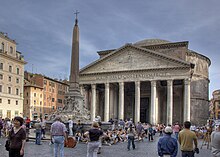



Architecture
Main article: Architecture of RomeAncient Rome
Main articles: List of ancient monuments in Rome and Ancient Roman architectureOne of the symbols of Rome is the Colosseum (70–80 AD), the largest amphitheatre ever built in the Roman Empire. Originally capable of seating 60,000 spectators, it was used for gladiatorial combat. A list of important monuments and sites of ancient Rome includes the Roman Forum, the Domus Aurea, the Pantheon, Trajan's Column, Trajan's Market, the Catacombs, the Circus Maximus, the Baths of Caracalla, Castel Sant'Angelo, the Mausoleum of Augustus, the Ara Pacis, the Arch of Constantine, the Pyramid of Cestius, and the Bocca della Verità.
Medieval
Often overlooked, Rome's medieval heritage is one of the largest in Italian cities. Basilicas dating from the Paleochristian age include Santa Maria Maggiore and San Paolo Fuori le Mura (the latter largely rebuilt in the 19th century), both housing precious 4th century AD mosaics. Later notable medieval mosaic and fresco art can be also found in the churches of Santa Maria in Trastevere, Santi Quattro Coronati, and Santa Prassede. Lay buildings include a number of towers, the largest being the Torre delle Milizie and the Torre dei Conti, both next the Roman Forum, and the huge staircase leading to the basilica of Santa Maria in Ara Coeli.
Renaissance and Baroque

Rome was a major world centre of the Renaissance, second only to Florence, and was profoundly affected by the movement. Among others, a masterpiece of Renaissance architecture in Rome is the Piazza del Campidoglio by Michelangelo. During this period, the great aristocratic families of Rome used to build opulent dwellings as the Palazzo del Quirinale (now seat of the President of the Italian Republic), the Palazzo Venezia, the Palazzo Farnese, the Palazzo Barberini, the Palazzo Chigi (now seat of the Italian Prime Minister), the Palazzo Spada, the Palazzo della Cancelleria, and the Villa Farnesina.
Many of the famous city's squares - some huge, majestic and often adorned with obelisks, some small and pictoresque - got their present shape during the Renaissance and Baroque. The principal ones are Piazza Navona, Piazza di Spagna, Campo de' Fiori, Piazza Venezia, Piazza Farnese, Piazza della Rotonda and Piazza della Minerva. One of the most emblematic examples of Baroque art is the Fontana di Trevi by Nicola Salvi. Other notable 17th-century baroque palaces are the Palazzo Madama, now the seat of the Italian Senate and the Palazzo Montecitorio, now the seat of the Chamber of Deputies of Italy.
Neoclassicism
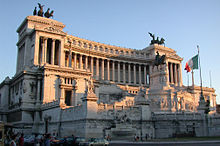
In 1870, Rome became the capital city of the new Kingdom of Italy. During this time, neoclassicism, a building style influenced by the architecture of antiquity, became a predominant influence in Roman architecture. During this period, many great palaces in neoclassical styles were built to host ministries, embassies, and other governing agencies. One of the best-known symbols of Roman neoclassicism is the Monument of Vittorio Emanuele II or "Altar of the Fatherland", where the Grave of the Unknown Soldier, that represents the 650,000 Italians that fell in World War I, is located.
Fascist architecture
See also: Fascist architectureThe Fascist regime that ruled in Italy between 1922 and 1943 developed an architectural style that was characterised by its links with ancient Roman architecture. The most important Fascist site in Rome is the E.U.R district, designed in 1938 by Marcello Piacentini. It was originally conceived for the 1942 world exhibition, and was called "E.42" ("Esposizione 42"). The world exhibition, however, never took place because Italy entered the Second World War in 1940. The most representative building of the Fascist style at E.U.R. is the Palazzo della Civiltà Italiana (1938–1943), the iconic design of which has been labelled the cubic or Square Colosseum. After World War II, the Roman authorities found that they already had the seed of an off-centre business district of the type that other capitals were still planning (London Docklands and La Défense in Paris). Also the Palazzo della Farnesina, the current seat of Italian Foreign Ministry, was designed in 1935 in Fascist style.
Parks and gardens
Main article: List of parks and gardens in Rome

Public parks and nature reserves cover a large area in Rome, and the city has one of the largest areas of green space amongst European capitals. The most notable part of this green space is represented by the large number of villas and landscaped gardens created by the Italian aristocracy. While many villas were destroyed during the building boom of the late 19th century, a great many remain. The most notable of these are Villa Borghese, Villa Ada, and Villa Doria Pamphili. Villa Doria Pamphili is west of the Gianicolo hill comprising some 1.8 km2. Also on the Gianicolo hill there is Villa Sciarra, with playgrounds for children and shaded walking areas. In the nearby area of Trastevere the Orto Botanico (Botanical Garden) is a cool and shady green space. The old Roman hippodrome (Circus Maximus) is another large green space but the main attraction is the ancient site of the chariot racing and it has few trees. Nearby is the lush Villa Celimontana, close to the gardens surrounding the Baths of Caracalla and Rose Garden (‘roseto comunale’). The Villa Borghese garden is the best known large green space in Rome, with famous art galleries among its shaded walks. It is close to the Spanish Steps and Piazza del Popolo. Rome also has a number of regional parks of much more recent origin including the Pineto Regional Park and the Appian Way Regional Park. There are also nature reserves at Marcigliana and at Tenuta di Castelporziano.
Fountains and aqueducts
Main articles: List of fountains in Rome and List of aqueducts in the city of Rome

Rome is a city famous for its numerous fountains, built in all different styles, from Classical and Medieval, to Baroque and Neoclassical. The city has had fountains for more than two thousand years, and they have provided drinking water and decorated the piazzas of Rome. During the Roman Empire, in 98 A.D., according to Sextus Julius Frontinus, the Roman consul who was named curator aquarum or guardian of the water of the city, Rome had nine aqueducts which fed 39 monumental fountains and 591 public basins, not counting the water supplied to the Imperial household, baths and owners of private villas. Each of the major fountains was connected to two different aqueducts, in case one was shut down for service. During the 17th and 18th century the Roman popes reconstructed other ruined Roman acqueducts and built new display fountains to mark their termini, launching the golden age of the Roman fountain. The fountains of Rome, like the paintings of Rubens, were expressions of the new style of Baroque art. They were crowded with allegorical figures, and filled with emotion and movement. In these fountains, sculpture became the principal element, and the water was used simply to animate and decorate the sculptures. They, like baroque gardens, were "a visual representation of confidence and power."
Statues
Main article: Talking statues of Rome


Rome is well known for its statues but, in particular, the talking statues of Rome. These are usually ancient statues which have become popular soapboxes for political and social discussion, and places for people to (often satirically) voice their opinions. There are two main talking statues: the Pasquino and the Marforio, yet there are four other noted ones: il Babuino, Madame Lucrezia, il Facchino and Abbot Luigi. Most of these statues are ancient Roman or classical, and most of them also depict mythical gods, ancient people or legendary figures; il Pasquino represents Menelaus, Abbot Luigi is an unknown Roman magistrate, il Babuino is supposed to be Silenus, Marforio represents Oceanus, Madame Lucrezia is a bust of Isis, and il Facchino is the only non-Roman statue, created in 1580, and not representing anyone in particular. They are often, due to their status, covered with placards or graffiti expressing political ideas and points of view. Other statues in the city, which are not related to the talking statues, include those of the Ponte Sant'Angelo, or several monuments scattered across the city, such as that to Giordano Bruno in the Campo de'Fiori.
Obelisks and columns
Main article: List of obelisks in Rome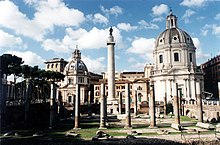

The city contains eight ancient Egyptian and five ancient Roman obelisks, together with a number of more modern obelisks; there was also formerly (until 2005) an ancient Ethiopian obelisk in Rome. The city contains some of obelisks in piazzas, such as in Piazza Navona, St Peter's Square, Piazza Montecitorio, and Piazza del Popolo, and others in villas, thermae parks and gardens, such as in Villa Celimontana, the Baths of Diocletian, and the Pincian Hill. Moreover, the centre of Rome hosts also Trajan's and Antonine Column, two ancient Roman columns with spiral relief.
Bridges
Main article: List of bridges in RomeThe city of Rome contains numerous famous bridges which cross the Tiber. Famous ones include the Ponte Cestio, the Ponte Milvio, the Ponte Nomentano, the Ponte Sant'Angelo, the Ponte Vittorio Emanuele II, the Ponte Sisto and the Ponte dei Quattro Capi. Currently there are five ancient Roman bridges still remaining in the city. Most of the city's public bridges were built in Classical or Renaissance style, but also in Baroque, Neoclassical and Modern styles. According to the Encyclopædia Britannica, the finest ancient bridge remaining in Rome is the Ponte Sant'Angelo, which was completed in 135AD, and was decorated with 10 statues of the angels, designed by Bernini in 1688.

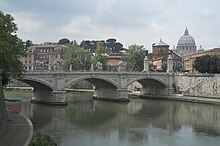
Catacombs
Main article: Catacombs of RomeRome has extensive amount of ancient catacombs, or underground burial places under or near the city, of which there are at least forty, some discovered only in recent decades. Though most famous for Christian burials, they include pagan and Jewish burials, either in separate catacombs or mixed together. The first large-scale catacombs were excavated from the 2nd century onwards. Originally they were carved through tuff, a soft volcanic rock, outside the boundaries of the city, because Roman law forbade burial places within city limits. Currently maintenance of the catacombs is in the hands of the Papacy which has invested in the Salesians of Don Bosco the supervision of the Catacombs of St. Callixtus on the outskirts of Rome.
Economy
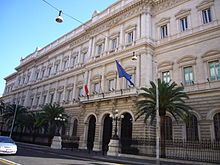
With a 2005 GDP of €94.376 billion (US$121.5 billion), the city produces 6.7% of the national GDP (more than any other single city in Italy), and its unemployment rate, lowered from 11.1% to 6.5% between 2001 and 2005, is now one of the lowest rates of all the European Union capital cities. Rome grows +4.4% annually and continues to grow at a higher rate in comparison to any other city in the rest of the country. This means that were Rome a country, it would be the world's 52nd richest country by GDP, near to the size to that of Egypt. Rome also had a 2003 GDP per capita of €29,153 (US$ 37,412), which was second in Italy, (after Milan), and is more than 134.1% of the EU average GDP per capita. Rome, on the whole, has the highest total earnings in Italy, reaching €47,076,890,463 in 2008, yet, in terms of average workers' incomes, the city places itself 9th in Italy, with €24,509, coming after Treviso (€24,593) and Siena (€24,549), and surpassing Parma (€24,456) and Varese (€24,045). On a global level, Rome's workers receive the 30th highest wages in 2009, coming three places higher than in 2008, in which the city was 33rd. This means that, whilst gross average earnings are less than Madrid and Barcelona, they are more than some other cities, such as Athens, Lisbon, Dubai and Hong Kong.
Although the economy of Rome is characterised by the absence of heavy industry and it is largely dominated by services, high-technology companies (IT, aerospace, defence, telecommunications), research, construction and commercial activities (especially banking), and the huge development of tourism are very dynamic and extremely important to its economy. Rome's international airport, Fiumicino, is the largest in Italy, and the city hosts the head offices of the vast majority of the major Italian companies, as well as the headquarters of three of the world's 100 largest companies: Enel, Eni, and Telecom Italia.
Universities, national radio and television and the movie industry in Rome are also important parts of the economy: Rome is also the hub of the Italian film industry, thanks to the Cinecittà studios, working since the 1930s. The city is also a centre for banking and insurance as well as electronics, energy, transport, and aerospace industries. Numerous international companies and agencies headquarters, government ministries, conference centres, sports venues, and museums are located in Rome's principal business districts: the Esposizione Universale Roma (EUR); the Torrino (further south from the EUR); the Magliana; the Parco de' Medici-Laurentina and the so-called Tiburtina-valley along the ancient Via Tiburtina.
Tourism

Tourism is Rome's chief industry, with numerous notable museums including the Vatican Museum, the Borghese Gallery, and the Musei Capitolini: in 2005 the city registered 19.5 million visitors, up of 22.1% from 2001. In 2006 Rome was visited by 6.03 million international tourists, reaching the 8th place in the ranking of the world's 150 most visited cities. Rome is also the third most visited city in the EU, and its historic centre, along with "the Properties of the Holy See in that City Enjoying Extraterritorial Rights and San Paolo Fuori le Mura," is listed by UNESCO as a World Heritage Site. The World Heritage site was extended in 1990 to the walls of Urban VIII, to include the Forums, the Mausoleum of Augustus, the Mausoleum of Hadrian, the Pantheon, Trajan’s Column and the Column of Marcus Aurelius, as well as the religious and public buildings of papal Rome.
The city's international branding has proved to be successful; in terms of marketing, the city ranks ninth worldwide, yet in terms of attractions and touristic assets, it ranks sixth. According to one study, Rome has several touristic sights, monuments and an attractive atmosphere which makes it one of the top cities cities in terms of branding. Its communication is less effective than other cities such as Berlin, but it remains in the top ten most commercially successful cities.
Rome has become the latest city to brand itself. Aimed primarily at the online audience, city authorities hope that the newly adopted logo will soon become a readily recognisable image which will help to promote the city around the world. Public monuments and buildings, such as the Vatican Museums and the Colosseum are amongst the world's 50 most visited tourist destinations (the Vatican Museums receiving 4.2 million tourists and the Colosseum receiving 4 million tourists every year).
Education
Rome is a nation-wide and major international centre for higher education, containing numerous academies, colleges and universities. According to the City Brands Index, Rome is considered the world's second most historically, educationally and culturally interesting and beautiful city. It boasts a large variety of academies and colleges, and has always been a major worldwide intellectual and educational centre, especially during Ancient Rome and the Renaissance, along with Florence.
Libraries

Rome's major libraries include: the Biblioteca Angelica, opened in 1604, making it Italy's first public library; the Biblioteca Casanatense, opened in 1701; the Biblioteca Vallicelliana; Bibliotheca Hertziana – Max Planck Institute of Art History, a German library located in Rome, often noted for excellence in the arts and sciences; the [[National Central Library (Rome)|National Central Libr oggi", n. 3, aprile 2009, p. 41.</ref> and the Vatican Library, one of the ol
- "Superficie di Comuni Province e Regioni italiane al 9 ottobre 2011". Italian National Institute of Statistics. Retrieved 16 March 2019.
- "Demography in Figures". Istituto nazionale di statistica (ISTAT). June 2010.
- OECD (2006). "OECD Territorial Reviews: Competitive Cities in the Global Economy" (PDF). p. 39. Retrieved 30 April 2009.
- "Rome, city, Italy". Columbia Encyclopedia (6th ed.). 2009.
- ^ Bremner, Caroline (12 December 2008). "Euromonitor International's Top City Destinations Ranking". Euromonitor International. Retrieved 2 March 2010.
- ^ "European city brands". City Mayors. 28 August 2008. Retrieved 14 June 2010.
- ^ "Historic Centre of Rome, the Properties of the Holy See in that City Enjoying Extraterritorial Rights and San Paolo Fuori le Mura". UNESCO World Heritage Center. Retrieved 8 June 2008.
- ^ "Itv News | The 50 Most Visited Places in The World". Itvnews.tv. Retrieved 17 October 2009.
- Claudio Rendina, Roma ieri, oggi, domani, Newton Compton, Roma, 2007, pg. 17
- This hypothesis originates from the Roman Grammarian Maurus Servius Honoratus.
- This hypothesis originates from Plutarch
- Heiken, G., Funiciello, R. and De Rita, D. (2005), The Seven Hills of Rome: A Geological Tour of the Eternal City. Princeton University Press.
- Livy, Ab Urbe Condita I, 7
- "Rome: Pre-20th-Century History". Lonely Planet. Retrieved 4 July 2008.
- Wilford, John Nobel (12 June 2007). "More Clues in the Legend (or Is It Fact?) of Romulus". New York Times. Retrieved 11 August 2008.
- Livy, Ab Urbe Condita V.
- CosmoLearning. "Greco-Roman World - Greece (3650 BC-146 BC)". Cosmolearning.com. Retrieved 3 February 2010.
- ^ "Augustus (63 BC - AD 14)". Historical Figures. British Broadcasting Company. Retrieved 3 February 2010.
- "Julius Caesar - Roman Dictator". h2g2. British Broadcasting Company. Retrieved 3 February 2010.
- "Pax Romana". Unrv.com. Retrieved 3 February 2010.
- "University of Chicago". Penelope.uchicago.edu. Retrieved 3 February 2010.
- Population crises and cycles in history. A review of the book Population Crises and Population cycles by Claire Russell and W.M.S. Russell.
- Italian Peninsula, 500–1000 A.D., The Metropolitan Museum of Art
- "Pope Alexander VI". Nndb.com. Retrieved 3 February 2010.
- work=Catholic Enclclopedia "Basilica of St. Peter". Newadvent.org. 1 February 1912. Retrieved 3 February 2010.
{{cite web}}: Check|url=value (help); Missing pipe in:|url=(help) - ^ CTI, Guida d'Italia, Vol. IV, pg. 22
- CTI, Guida d'Italia, Vol. IV, pg. 23
- woth=Catholic Encyclopedia "Pope Pius IX". Newadvent.org. Retrieved 3 February 2010.
{{cite web}}: Check|url=value (help) - IMDb.com
- "Candidate Cities for Future Olympic Games". Bladesplace.id.au. Retrieved 17 October 2009.
- "The World According to GaWC 2008". Lboro.ac.uk. 3 June 2009. Retrieved 3 February 2010.
- "The 2008 Global Cities Index". Foreignpolicy.com. 15 October 2008. Retrieved 3 February 2010.
- "Maxxi_Museo Nazionale Delle Arti Del Xxi Secolo". Maxxi.beniculturali.it. Retrieved 25 March 2010.
- "Auditorium Parco della Musica". Auditorium.com. Retrieved 25 March 2010.
- "ROME | Congress Center Italia EUR "Nuvola di Fuksas" (Fuksas)". SkyscraperCity. Retrieved 25 March 2010.
- ITVnews.tv
- Originally founded as circoscrizioni in 1972, they became municipi in 2001: "Territorio" (in Italian). Comune di Rome. Retrieved 5 October 2009.
- "The "Rioni" of Rome". Romeartlover.it. Retrieved 3 February 2010.
- "University of Oregon". Nolli.uoregon.edu. 25 September 2006. Retrieved 3 February 2010.
- Ravaglioli, Armando (1997). Roma anno 2750 ab Urbe condita (in Italian). Rome: Tascabili Economici Newton. ISBN 888183670X.
- "World Map of Köppen−Geiger Climate Classification".
- "Snow in Rome". London: guardian.co.uk. 12 February 2010. Retrieved 14 February 2010.
- "Visualizzazione tabella CLINO della stazione / CLINO Averages Listed for the station Roma Ciampino". Retrieved 16 June 2010.
- "Visualizzazione tabella CLINO della stazione / CLINO Averages Listed for the station Roma Fiumicino". Retrieved 16 June 2010.
- "Statistiche demografiche ISTAT". Demo.istat.it. Retrieved 3 February 2010.
- Rome Post - what's happening in Rome
- Coarelli, p. 308.
- "Green Areas". RomaPerKyoto.org. Archived from the original on 4 February 2008. Retrieved 9 November 2008.
- Frontin, Les Aqueducs de la ville de Rome, translation and commentary by Pierre Grimal, Société d'édition Les Belles Lettres, Paris, 1944.
- Italian Gardens, a Cultural History, Helen Attlee. Francis Lincoln Limited, London 2006.
- "Chasing Obelisks in Rome". Initaly.com. Retrieved 3 February 2010.
- "The Bridges of Ancient Rome". Citrag.it. Retrieved 3 February 2010.
- "Sant'Angelo Bridge". Encyclopædia Britannica. Retrieved 3 February 2010.
- ^ "Rapporto Censis 2006". Censis.it. Retrieved 3 February 2010.
- Observatoribarcelona.org
- ^ "La classifica dei redditi nei comuni capoluogo di provincia". Il Sole 24 ORE. Retrieved 14 June 2010.
- "World's richest cities in 2009". City Mayors. 22 August 2009. Retrieved 14 June 2010.
- DeCarlo, Scott (30 March 2006). "The World's 2000 Largest Public Companies". Forbes. Retrieved 16 January 2007.
- Caroline Bremner (11 October 2007). "Top 150 City Destinations: London Leads the Way". Euromonitor International. Retrieved 3 August 2008. This article has the complete list of 150 cities
- New logo for Rome
- "How the world views its cities" – The Anholt City Brands Index 2006
- "Roman Academies". Catholic Encyclopedia. Newadvent.org. 1 March 1907. Retrieved 3 February 2010.
- Max Planck Gesellschaft e.V (17 May 2006). "Max Planck Society – Hanno and Ilse Hahn Prize". Mpg.de. Retrieved 25 January 2010.
